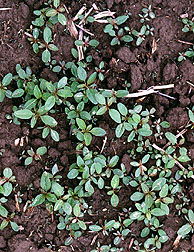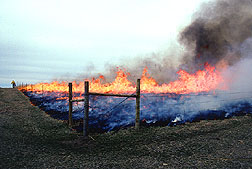Hard-To-Control Weeds Need a Mix of Measures
|
|
Farmers and land managers will have to become proficient at long-range planning for weed control—and also learn to use a mix of different techniques—to control weeds, say Agricultural Research Service scientists.
Hemp dogbane, waterhemp, leafy spurge, cocklebur, and thistle are becoming more difficult to control with one-step approaches such as using a single tillage method, annual crop rotations, or seasonal herbicide applications. The ARS scientists advocate use of integrated weed management systems that increase cost efficiency for farmers, promote more ecologically sustainable production, and conserve soil and water resources.
Weeds and weed control cost U.S. farmers about $15 billion each year.
Part of the problem is that the long-term use of specific herbicides has led to development of weeds with herbicide resistance. Another problem is that shifts in tillage practices make it easier for different types of weeds to get established. And some cropping patterns have discouraged competition among weed species, causing certain ones to spread and crowd out crops.
One scientist tackling weed problems in new ways is ARS range scientist Robert A. Masters. He is in the ARS Wheat, Sorghum, and Forage Research Unit at Lincoln, Nebraska.
Masters has combined herbicides, controlled burning, and replanting of native warm-season grasses—without tillage—to supplant leafy spurge, a noxious weed that threatens Northern Plains grasslands.
"The productive capacity of Great Plains grasslands has been reduced greatly by invasive weeds like leafy spurge," he says. "These weeds have displaced desirable native forages as well."
Leafy spurge was introduced into the northern Great Plains from Eurasia in the late 1800s. It has no natural enemies in this country, and herbicides provide only short-term control. Unlike sheep and goats, cattle and horses won't graze land infested with leafy spurge, and they avoid eating forage grasses growing next to the weed.
In field tests conducted between 1992 and 1995 in cooperation with scientists at the University of Nebraska, Masters applied a three-pronged strategy to fight leafy spurge. The result was a 60-percent reduction in spurge populations and a surge in production of warm-season grasses.
First, Masters applied a combination of the herbicides Arsenal and Oust to kill leafy spurge plants in the fall. He burned the dead plant residue the following spring. Then he planted native prairie species such as big bluestem, switchgrass, and indiangrass.
"Two years after planting," says Masters, "switchgrass and bluestem hay yields increased to over 4,000 pounds per acre, and indiangrass produced more than 3,000.
"Our goal is to develop economical, integrated weed management strategies that enable land managers to convert marginal cropland and degraded grasslands to high-value grasslands that are resistant to noxious weed invasion," he says. "In our current research, we're refining this strategy by using a combination of the herbicides Plateau and Roundup, in place of Arsenal and Oust, to promote establishment of mixtures of native grasses and legumes."
Loyd Wax, an agronomist at the ARS Crop Protection Research Laboratory in Urbana, Illinois, is taking a similar approach to thwart waterhemp, a species similar to redroot and smart pigweed.
Waterhemp biotypes have become increasingly resistant to ALS-inhibiting herbicides that block production of branched-chain amino acids, the building blocks of protein. Wax found super-resistant waterhemp biotypes that withstood up to 520 times the labeled rate of certain ALS-inhibiting herbicides.
To combat these ALS-resistant biotypes, Wax conducted studies showing that growers could markedly improve waterhemp control by combining non-ALS-inhibiting herbicides with cultivation. This strategy affords the grower two very different methods to control ALS-resistant waterhemp populations.
"We controlled established waterhemp populations with non-ALS herbicides and then tilled the soil at a depth that was not favorable to waterhemp seed germination and emergence," says Wax.
"We also found that we could combine sequential applications of non-ALS-inhibiting herbicides with the rapid canopy closure of close-drill soybeans for very good waterhemp control in no-tillage systems," he says.
"Farmers will greatly benefit from knowing which species of weeds are established in their fields and using this information when they plan crop rotations and farming operations. They should use a variety of farming techniques to control weeds. As farming systems change, weeds and weed populations change. So farmers can no longer expect one-shot solutions to weed problems."
They Fall Into Two Types
Annual weeds are plants that reproduce by seed and generally germinate each year to reproduce. This type of weed includes velvetleaf, cocklebur, and foxtail. The seeds of annual weeds have a better opportunity to germinate and grow into mature plants if they are buried in the soil. Seeds not buried tend not to germinate.
Perennial weeds regrow each year from roots or rhizomes—tubal extensions located below the soil surface. Perennial weeds include thistle, quackgrass, and milkweed. These weeds are usually controlled by tillage operations such as disking or cultivating.
A shift in tillage techniques is the culprit behind changes in the behavior of annual weeds such as velvetleaf, cocklebur, and foxtail, according to ARS agronomist Douglas D. Buhler of Ames, Iowa. He's seeking the right balance of tillage and cropping practices to knock down both annual weeds and perennials like thistle, quackgrass, and dogbane.
"Shifts in tillage practices bring about rapid shifts in weed populations," Buhler explains.
His research shows the population of hemp dogbane remained constant over 14 years when land operators disked or plowed their soil. Plowing disturbed the dogbane root systems and prevented the weed from spreading. When researchers switched to no-till farming systems on adjacent acreage—or to systems using no tillage before planting—dogbane populations exploded by 400 percent over the same 14-year period.
On the other hand, no-till tends to discourage
growth of annual weeds like velvetleaf and cocklebur. Buhler's research showed velvetleaf and cocklebur thrived in cultivated fields but were reduced by up to 80 percent in fields that were not tilled. — By Dawn Lyons-Johnson, Agricultural Research Service Information Staff, 1815 North University Street, Peoria, IL 61604, phone (309) 681-6534.
Robert A. Masters is in the USDA-ARS Wheat, Sorghum, and Forage Research Unit, 344 Keim Hall, P.O. Box 830937, Lincoln, NE 68583-0937; phone (402) 472-1546, fax (402) 472-4020.
Loyd Wax is in the USDA-ARS Crop Protection Unit, N-325 Turner Hall, University of Illinois, 1102 S. Goodwin, Urbana, IL 61801; phone (217) 333-9653, fax (217) 244-7703.
Douglas D. Buhler is at the USDA-ARS National Soil Tilth Laboratory, 2150 Pammel Dr., Ames, IA 50011-4420; phone (515) 294-5502, fax (515) 294-8125.
"Hard-To-Control Weeds Need a Mix of Measures" was published in the April 1998 issue of Agricultural Research magazine. Click here to see this issue's table of contents.









